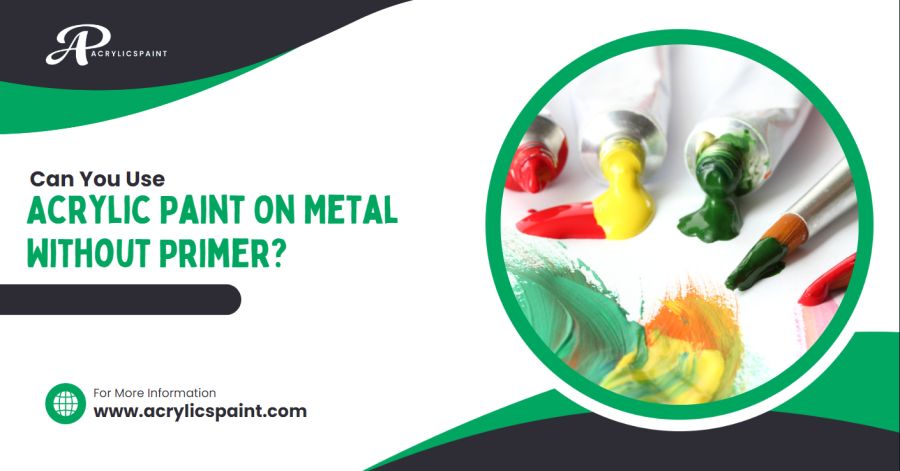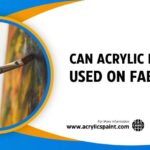Acrylic Paint On Metal – Acrylic paint boasts vibrant colours and fast drying times, making it a popular choice for many art projects. But can you skip the prep work and apply it directly to metal surfaces? Let’s explore the answer and the best practices for using acrylic paint on metal, with or without primer.
Why Primer Matters for Acrylic Paint on Metal
While technically, you can apply acrylic paint directly to metal, it’s generally not recommended. Here’s why primer plays a crucial role:
Slick Surface
Metal surfaces are naturally smooth, offering poor adhesion for paint. Primer creates a slightly textured surface that helps the acrylic paint grip better, preventing peeling and flaking over time.
Corrosion Resistance
Bare metal is susceptible to rust, especially outdoors. Primer often contains anti-corrosive properties, providing a protective layer between the metal and the paint.
Colour Vibrancy
Primer acts as a base coat, creating a more even surface for the acrylic paint. This can enhance the overall color vibrancy and opacity of your final artwork. In short, primer significantly improves the adhesion, durability, and overall finish of acrylic paint on metal.
Primer vs. No Primer
Using a primer on metal surfaces before applying acrylic paint is highly recommended. Primers create a barrier that helps the paint adhere more effectively and prevents rust formation. However, if you’re painting a small project or decorative item that won’t be exposed to harsh conditions, you may be able to skip the primer.
Can You Use Acrylic Paint on Metal Without Primer in a Pinch?
There might be situations where using acrylic paint without primer is tempting. It could be a small indoor project, or you don’t have primer. In such cases, here are some things to consider:
Limited Durability
Be prepared for the paint to be less chip-resistant and more prone to peeling, especially with exposure to moisture or abrasion.
Uneven Coverage
The paint may adhere unevenly to the bare metal, leading to a patchy appearance.
Metal Type
Smooth metals like aluminium present a more significant challenge for adhesion without primer. Rougher metals like galvanized steel might offer a slightly better grip. If you absolutely must skip the primer, ensure the metal surface is clean, dry, and free of any grease or oil. This will help the paint adhere slightly better. However, for best results, priming is always the recommended approach.
Alternatives To Using Metal Primer
While metal primer is highly recommended for using acrylic paint on metal, there can be situations where a substitute might be helpful. Here are a few alternatives to consider, but remember, these won’t offer the same level of adhesion and protection as a proper metal primer:
Light Sanding
For small, indoor projects on non-corrosive metals like aluminium, lightly sanding the surface with fine-grit sandpaper can create texture to help the paint adhere slightly better. However, this is not a substitute for primer and won’t offer significant protection against rust or peeling.
Multi-Surface Acrylic Paint
Some acrylic paint brands offer multi-surface varieties that claim to adhere to various materials, including metal. While these might work in a pinch, their effectiveness can vary. Test a small, inconspicuous area first to see how well the paint adheres.
Bonding Primer Alternatives
Strong bonding primers designed for other materials might work on metal in a limited way. Research options like “general purpose bonding primer” or “plastic bonding primer” to see if they specify the primer as compatible with metal. Again, test in an inconspicuous area first, and be aware that these might not offer the same level of corrosion resistance as a metal-specific primer.
Non-Stick Cooking Spray
Believe it or not, a light coat of non-stick cooking spray can be a temporary barrier for pouring. However, be very light-handed and test on a scrap piece of metal first!
Silicone Mold Release
Apply a thin layer of silicone mould release spray to the metal surface. This creates a temporary barrier that allows you to remove the dried acrylic art later.
Can Acrylic Paint Be Used on Metal?
Yes, you can indeed use acrylic paint on metal surfaces. Acrylic paint adheres well to various materials, including metal, making it a popular choice for artists and crafters. However, using it without a primer depends on several factors.
Does Acrylic Paint Work on Metal?
While acrylic paint can bond to metal surfaces, it may only adhere as effectively with proper surface preparation. Metal surfaces are often smooth and non-porous, making it challenging for paint to stick to them directly.
How to Prep Metal for Acrylic Paint (and Achieve Lasting Results)
For a project that will stand the test of time, take the time to prime the metal surface properly:
- Clean Up: Wash the metal thoroughly with a degreaser or mild soap solution. Remove any dirt, dust, or rust with a wire brush or sandpaper (depending on the severity). Rinse and allow the metal to dry completely.
- Prime Time: Choose a metal-specific primer suitable for acrylic paint. Apply a thin, even coat of primer and let it dry completely, following the instructions.
- Paint It Up: Once the primer is dry, you’re ready to apply your acrylic paint! Follow standard acrylic painting techniques, using thin layers and allowing each layer to dry completely before adding the next.
Tips for Painting on Metal with Acrylic
- Choose the Right Paint: Opt for acrylic paint specifically formulated on metal surfaces.
- Apply Thin Layers: Build up your paint layers gradually to achieve a smooth, even finish.
- Allow for Drying Time: Ensure each layer of paint is completely dry before applying the next one.
- Use Proper Ventilation: Work in a well-ventilated area or outdoors when painting with acrylics to avoid inhaling fumes.
How To Protect Your Acrylic Artwork on Metal
For additional protection, especially on outdoor projects or frequently used items, consider applying a coat of acrylic sealer after your paint completely dries. Choose a water-based acrylic sealer formulated explicitly for metal to ensure it is compatible with your paint.
In Conclusion
While acrylic paint can technically adhere to metal without primer, using a primer significantly improves the overall outcome. Priming metal before painting with acrylics is the recommended approach for a durable, vibrant, and long-lasting finish. With proper preparation and sealing, your acrylic creations on metal can shine for years to come!















